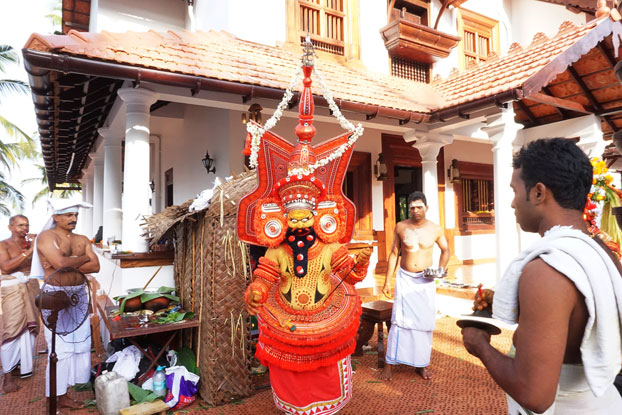

Kerala, the nature lover’s wonderland, the land of green groves and shimmering water can never disappoint anyone
and I was at Kannur to watch a Theyyam performance.

The distinct music of the chendamelam (a percussion musical of Kerala) could be heard at a distance. Theyyam is a form of worship where men impersonate the gods and dance to various musical accompaniments. This ritualistic art is popular in the North Malabar region comprising Kannur and Kasargod districts. Also known by kaliyaattom, this dance
form has its etymological origin from ‘Deivam’ meaning God in Malayalam.
Theyyam is generally performed in the theravad (ancestral home), temples or homes and fields as ancestor- worship. The invocation is said to bring prosperity and remove hazards. The Theyyam dance in one house I visited was a thanksgiving for the occupant’s recovery after being hospitalised for a fortnight. In another home I visited, it was being performed as part of the house-warming celebration.
Costume

The main attraction in Theyyam is the vibrant and awe-inspiring costumes of the artists. Elaborate headgear in various shapes based on the deity they depict, face painted red and intricately designed, eyes heavily done up with lamp soot, huge ornaments adorning their body — all these demand long hours of preparation prior to the performance. The costumes are made from painted coconut sheaths, coconut shells form the breastplates and coconut fronds are worn as skirts. The spirit of the deity is invoked during the night and the performance lasts for at least ten hours.
Each deity’s physical appearance conforms to an image envisaged centuries ago in the dream or vision of a respected guru, and the make-up and costume is in accordance with the image.
Theyyam rules
The Theyyam performers belong to a particular community (Vannan, Malayan, Velan, Parayan etc). Each community represents certain deities and hence must be knowledgeable about the mythology, rituals, make-up and costumes of that deity. They have their own jurisdiction and cannot perform in another locality.
Referred to as koladharis, these artists enjoy great importance during the rituals as they are worshipped as god and people share their grievances and seek blessings from them. “God resides in their body as soon as they begin the rituals and they are not aware of what they do or say when they are the ‘Theyyam’ and until the ‘malaiyettom’ (the send-off) is performed,” says Kannan, a Theyyam and a chendamelam performer. A government pleader by profession, he says that it is an inherited art; his father, grandfather and great grandfather were Theyyam artists, and now his ten-year-old son is also performing. “Although we imbibe by watching the elders perform, we attend rigorous training where we are prepared physically, mentally and spiritually,” he adds.
Only men are allowed to perform. A male inherit the shrine rights from his maternal side and after marriage also acquires the shrine rights of the wife’s family.
Santosh, a carpenter by profession, but in the guise of Pottan Theyyam at Mandira’s house where I was watching his performance, chided me in Malayalam for leaving my hair untied when I went up to him to seek the deity’s blessings. “You must tie up your hair when you visit a temple,” he said, while predicting my future. Later, I was taken aback to find him a young boy hidden under heavy make-up, smiling shyly and asking how I enjoyed the performance.
There are 450 forms of Theyyam which branched out from 35 original forms. Pottan, Vishnumurthy, Vayanaatu Kulavan, Gulikan and Rakthachamundi are few popular Theyyams. Each Theyyam is based on one deity; Pottan is the incarnation of Shiva, Vishnumurthy is of Lord Vishnu and Rakthachamundi is of the Mother Goddess referred to as Bhagawathy. They have various mythological tales associated with them.
Kannan related the tale of Pottan: A childless Brahmin couple found an infant by the riverbank, took him home and reared him lovingly. When the boy grew up, he was interested in non-vegetarian food, hunting and non-sattvic rituals. (He was Lord Shiva in the incarnation of a hunter.) One day his mother dissuaded him from such violent activities. The boy, suppressing his anger, stared at a passing deer and it turned into ashes. The horrified mother realised who he was and prayed to blindfold his eyes to safeguard the world at large.
This explained why the Theyyam in Mandira’s house had plates covering his eyes.
Dance
The initial performance — vellattom — is done sans decorative costumes. The thudangal (beginning) and thottam (invocation) form the introductory rituals wherein the dancer comes in front of the shrine and gradually “metamorphoses” into the deity of that shrine. He then dons the headgear and dances to the accompaniment of the musical instruments, then takes a shield and kadthala (sword) in his hands, circumambulates the shrine and moves into the courtyard. The steps are called kalaasam. Some Theyyams such as the ‘Ottakolam’ performed for Lord Vishnu’s incarnation as Narasimha, involve supernatural feats such as the artist walking through a bonfire several times; it is believed that performing such an act 104 times elevates the koladhari to the status of a panikker.
Unusual offering
I was quite surprised when I smelt fish in the prasad that was given to me, and even more was in store for me when I found the men drinking something akin to milk. Kannan enlightened me stating that since Lord Shiva (Pottan) was a hunter, he ate anything he could lay his hands on while roaming in the forests. Hence the deity is offered meat and fish and toddy as prasad. The Theyyam artists also take sips of toddy during the dance.
The Parasinikadavu Muthappan temple in Kannur is largely associated with Theyyam which is performed everyday here. Mid-October-November and mid-May-June are the peak seasons for Theyyam performances here.
Pictures by Jaishree





